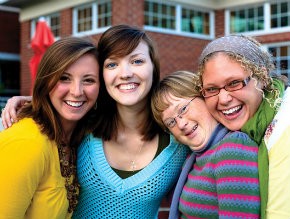Roommates and friends: A seminary does disability ministry

On a Sunday morning in the spring of 2005, Deb and Bob Sterken went as usual to church in Holland, Michigan. But this Sunday they arrived with a special mission: to talk to Matt Floding, the dean of students at Western Theological Seminary. The Sterkens’ adult son Rob had Down syndrome, and they had been told that Dean Floding might be able to help Rob find appropriate housing.
The Sterkens had been running into the same barriers that millions of parents of adults with disabilities encounter. Their son wanted to live independently, and they believed he no longer required the constant oversight of his parents. Yet he needed a safe place with some support in order to navigate the tasks and challenges of daily living.
At first, Floding didn’t know what Rob Sterken’s situation could possibly have to do with Western Seminary. But Floding had been reading a book by Luther Snow called The Power of Asset Mapping. Floding connected the premise of Snow’s book to the conversation he had with the Sterkens in the back of the church that Sunday.




